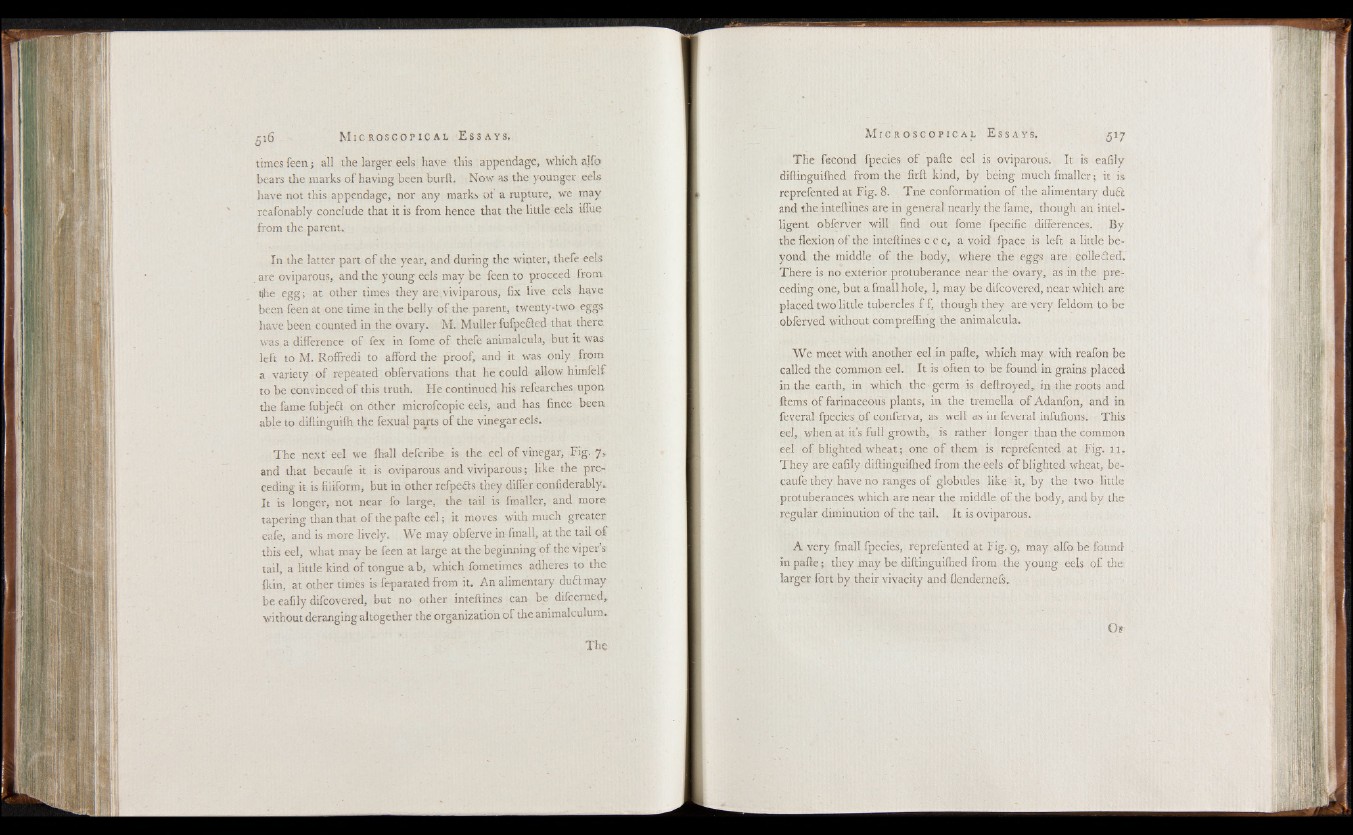
times feen; all the larger eels have this appendage, which a!fo
bears the marks of having been burft. Now as the younger eels
have not this appendage, nor any marks of a rupture, we may
reafonably conclude that it is from hence that the little eels ilfue
from the parent.
In the latter part o f the year, and during the winter, thefe eels
are oviparous, and the young eels may be feen to proceed from
tjhe egg; at other times they are,viviparous, fix live eels have
been feen at one time in the belly o f the parent, twenty-two eggs
have been counted in the ovary. M. Muller fufpefted that there
was a difference o f fex in fome of thefe animalcula, but it was
left to M. Roffredi to afford the proof, and it was only from
a variety of repeated obfervations that he could allow himfelf
to be convinced of this truth. He continued his refearches upon
the fame fubjefl on other microfcopic eels, and has fince been
able to diftinguifh the fexual parts of the vinegar eels.
The next' eel we {hall defcribe is the eel o f vinegar, Fig. 7,
and that becaufe it is oviparous and viviparous; like the preceding
it is filiform, but in other refpedfs they differ confiderably-
It is longer, not near fo large, the tail is fmaller, and more
tapering than that of the pafte eel; it moves with much greater
eafe, and is more lively. We may obferve in fmall, at the tail o f
this eel, what may be feen at large at the beginning of the viper’s;
tail, a little kind of tongue ab, which fometimes adheres to the
fkin, at other times is feparated from it. An alimentary duel may
be eafily difeovered, but no other inteftines can be difeerned,
without deranging altogether the organization of the animalculum.
The
The fecond fpecies o f pafte eel is oviparous. It is eafily
diflinguifhed from the firft kind, by being much fmaller; it is
reprefented at Fig. 8. Tne conformation of the alimentary duff
and the inteftines are in general nearly the fame, though an intelligent
obferver will find out fome fpecific differences. By
the flexion of the inteftines c c c, a void fpace is left a little beyond
the middle of the body, where the eggs are collected.
There is no exterior protuberance near the ovary, as in the preceding
one, but a fmall hole, 1, may be difeovered, near which are
placed two little tubercles f f, though they are very feldom to be
obferved without comprefling the animalcula.
We meet with another eel in pafte, which may with reafon be
called the common eel. It is often to be found in grains placed
in the earth, in which the ■ germ is deftroyed, in the roots and
ftems of farinaceous plants, in the tremella o f Adanfon, and in
feveral fpecies o f conferva, as well as in feveral infufions. This
eel, when at it’s full growth, is rather longer than the common
eel o f blighted wheat; one o f them is reprefented at Fig. 11.
They are eafily diftinguifhed from the eels o f blighted wheat, becaufe
they have no ranges of globules like it, by the two little
protuberances which are near the middle of the body, and by the
regular diminution of the tail. It is oviparous.
A very fmall fpecies, reprefented at Fig. g, may alfo be found
in pafte; they may be diftinguifhed from the young eels of the
larger fort by their vivacity and flendernefs.
O p